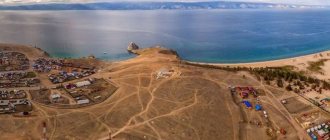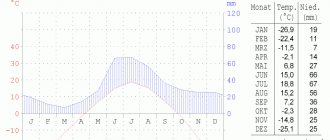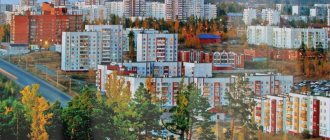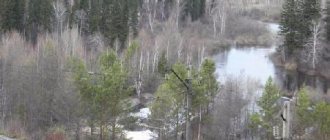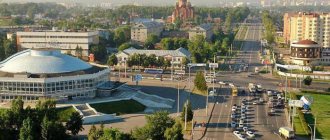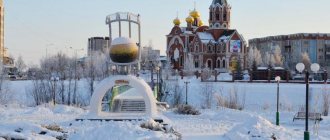For other uses, see Zheleznogorsk.
City in Irkutsk region, Russia
| Zheleznogorsk-Ilimsky Zheleznogorsk-Ilimsky | |
| City [1] | |
| Zheleznogorsk-Ilimsky | |
| Coat of arms | |
| Location of the city of Zheleznogorsk-Ilimsky | |
| Zheleznogorsk-Ilimsky Location of the city of Zheleznogorsk-Ilimsky Show map of Russia Zheleznogorsk-Ilimsky Zheleznogorsk-Ilimsky (Irkutsk region) Show map of Irkutsk region | |
| Coordinates: 56°35'N 104°08'E / 56.583°N 104.133°E / 56.583; 104.133 Coordinates: 56°35'N 104°08'E. / 56.583°N 104.133°E / 56.583; 104.133 | |
| A country | Russia |
| Federal subject | Irkutsk region [1] |
| Administrative region | Nizhneilimsky district [2] |
| Based | 1948 |
| City status from | 1965 |
| Government | |
| • Mayor | Semyon Gendelman |
| Height | 430 m (1410 ft) |
| population size (2010 Census) [3] | |
| • General | 26 079 |
| • Evaluate (2018) [4] | 23 412 ( -10,2% ) |
| Administrative status | |
| • Capital from | Nizhneilimsky district [5] |
| Municipal status | |
| • Municipal district | Nizhneilimsky municipal district [6] |
| • Urban village | Urban settlement Zheleznogorskoe [6] |
| • Capital from | Nizhneilimsky municipal district [6], urban settlement Zheleznogorskoye [6] |
| Timezone | UTC+8 (MSK+5[7]) |
| Postal code [8] | 665650, 665651, 665653, 665654 |
| Dial code(s) | +7 39566 |
| OKTMO ID | 25626101001 |
| Web site | Zhel-Ilimskoye .irkobl .ru |
Zheleznogorsk-Ilimsky
(Russian: Zheleznogorsk-Ilimsky, IPA: [ʐɪlʲɪznɐgorsk ɪlʲimskʲɪj]) is a city and the administrative center of Nizhneilimsky District in Irkutsk Oblast, Russia, located 478 km (297 mi) north of Irkutsk, the administrative center of the region. Population: 26,079 (2010 census); [3] 29,093 (2002 census); [9] 32,326 (1989 census). [10]
Story
In the 17th century, ore explorer Shestachko Korshunov discovered an iron ore deposit near Mount Zheleznaya in the north of the Angara region. The Korshunikha River, a tributary of the Ilim, was named after his surname, and it, in turn, gave the name to the village that was formed here in 1948. With the beginning of modern ore mining, the village became Zheleznogorsk, and in 1965 received the status of a city, the definition of Ilimsky in the name and The city-forming enterprise is the Korshunovsky mining and processing plant. A year earlier, CHPP-16 of Irkutskenergo was put into operation.
The large Komsomol construction project of the 1950s–1960s brought together young people and experienced specialists from all over the country in the village.
Here, for the first time in Eastern Siberia, the wide-format cinema “Ilim” was built in 1969 (burnt down in 2010, restored in 20181).
Some events in the history of Zheleznogorsk-Ilimsky
| XVII century | Russian ore explorer Shestak Korshunov discovered an “iron stone” in Priilimye |
| 1647 | Along the banks of the Ilim, 27 km from modern Zheleznogorsk-Ilimsky, the “sovereign house” was founded (now the village of Shestakovo is located here). The iron products it produced came to Ilimsk, Ust-Kut and Verkholensk. |
| XIX | Iron ore deposits were discovered in the areas of modern Ermakovskoye, Kezhemskoye, Dolonovskoye and Krasnoyarovskoye deposits. |
| 1847 | The Nikolaev Ironworks was built. |
| 1895 | The Luchikhinsky ironworks was built. |
| 1924 | The Nikolaevsky and Luchikhinsky ironworks ceased to exist. |
| 1930s | The idea of reviving metallurgical production in the Angara region and creating on this basis the country's third metallurgical base is being considered. This idea was approved at the XVIII Congress of the All-Union Communist Party (Bolsheviks), the resolution of which noted the need for the construction of the East Siberian Metallurgical Plant and the development of other industries in the Angara region. |
| 1947 | The possibility of creating a large metallurgical production facility in the Angara region is widely discussed at the Conference on the Study of the Productive Forces of the Irkutsk Region. |
| 1948 | The presence of a large iron ore deposit has been confirmed in the Nizhneilimsk region. A settlement of geologists and builders, named Korshunikha, was founded near the deposit. |
| 1950s | The Taishet-Lena railway was put into operation. The Korshunikha railway station was opened. |
| 1957 | The first landing force arrived at the Korshunikha-Angarskaya station for the construction of a mining and processing plant. |
| 1958 | The builders' settlement received the status of a workers' settlement and a new name - Zheleznogorsk. |
| 1965 | The Korshunovsky GOK was put into operation. The workers' settlement of Zheleznogorsk received city status. The word “Ilimsky” was added to its name. |
| 1970-1980s | A swimming pool, a large-format cinema, an ice rink, a ski slope, new modern residential areas, a railway tunnel (950 m), etc. were built. |
| 2002 | From May to October, the Korshunovsky GOK was in crisis; production and shipment of products were stopped. During the year, only 1,354 thousand tons of concentrate were produced (the smallest amount since the launch of the mining and processing plant). |
| 2005 | With financial assistance from the Mechel group and the Korshunovsky Mining and Processing Plant, an Orthodox church was erected in the city. |
| 2008 | The second Korshunovsky railway tunnel (950 m) was built. |
Read on Irkipedia:
- Zheleznogorsk-Ilimsky // “Historical Encyclopedia of Siberia” (2009)
- Zheleznogorsk-Ilimsky // Great Soviet Encyclopedia, 3rd ed. (1969-78)
Climate
The average long-term duration of the frost-free period in Zheleznogorsk-Ilimsky is about 90 days. The first frosts are recorded on September 10, the last - on May 29.
Absolute temperatures in January drop to -46 °C, and in July rise to +34 °C. The average annual temperature is -2.6 °C.
On average, 470 mm of precipitation falls annually, of which 53% falls in May-August.
Geography
Zheleznogorsk-Ilimsky is located in the Middle Angara region, 1224 km north of the regional center by rail and 480 km in a straight line. The Taishet-Lena railway passes through it. The city is located 16 km from the Ilim River. Korshunikha-Angarskaya railway station is on the western BAM, belonging to the East Siberian Railway.
The city is surrounded by hilly, forested terrain. The absolute height of the surrounding hills reaches 610 m above sea level. The height difference within the city is about 100 m. One of the mountains blocks the entrance to Zheleznogorsk-Ilimsky by rail; a 950 m long tunnel was built through it.
Distance from Zheleznogorsk-Ilimsky to some cities, km
| City | Distance | |
| by rail | by road | |
| Ust-Kut | 168* | 138 |
| Ust-Ilimsk | 235 | 521 |
| Bratsk | 262*** | 261 |
| Vikhorevka | 286 | 304 |
| Taishet | 555 | 766 |
| Nizhneudinsk | 718 | 609 |
| Tulun | 835 | 486 |
| Krasnoyarsk | 973 | 1135 |
| Winter | 974 | 619 |
| Cheremkhovo | 1094 | 736 |
| Usolye-Sibirskoye | 1157 | 809 |
| Angarsk | 1185 | 840 |
| Irkutsk | 1224 | 884 |
| Shelekhov | 1244 | 902 |
| Slyudyanka | 1350 | 996 |
| Baykalsk | 1385 | 1035 |
| Ulan-Ude | 1680 | 1334 |
*From Korshunikha-Angarskaya station.
**To Lena station.
***To Anzebi station.
Topographic map of square O-48-B 1980 (Zheleznogorsk-Ilimsk, Ust-Ilimsk)
Zheleznogorsk-Ilimsky
(Irkutsk region)
OKATO code:
25226501
Founded:
1957
Urban settlement since:
1958
City since:
1965 City of district subordination (Nizhneilimsky district, Irkutsk region)
Center:
Nizhneilimsky district
Telephone code (reference phone)
| 39566***** | 22-9-20 |
Deviation from Moscow time, hours:
5
Geographic latitude:
56°35′
Geographic longitude:
104°07′
Altitude above sea level, meters:
430 Sunrise and sunset times of the Sun and Moon in the city of Zheleznogorsk-Ilimsky
Population
Population dynamics
| 1959 | 1967 | 1970 | 1979 | 1989 | 1992 | 1996 | 1998 | 2000 |
| 2000 | 17 000 | 22 179 | 29 087 | 32 326 | 32 800 | 33 700 | 33 200 | 32 300 |
| 2001 | 2002 | 2003 | 2005 | 2006 | 2007 | 2008 | 2009 | 2010 |
| 31 500 | 29 093 | 29 100 | 27 800 | 27 200 | 26 900 | 26 600 | 26 352 | 26 079 |
| 2011 | 2012 | 2013 | 2014 | 2015 | 2016 | 2017 | 2018 | 2019 |
| 25 953 | 25 446 | 24 955 | 24 505 | 24 235 | 23 979 | 23 643 | 23 412 | 23 137 |
| 2020 | ||||||||
| 22 950 |
Economy
The main occupation of the residents is work at the Korshunovsky Mining and Processing Plant, the railway, and in budgetary institutions of the city.
Main enterprises:
- Korshunovsky Mining and Processing Plant OJSC Korshunovsky GOK (part of Mechel OJSC) is a city-forming enterprise (offers iron ore concentrate);
- Combined heat and power plant - ITETs-16;
- food industry enterprises;
- organization of railway transport;
- retail trade organizations;
- JSC "Zhdanovsky Timber Industry Enterprise"
Read on Irkipedia:
- Korshunovsky GOK extends the life of Zheleznogorsk-Ilimsky
- Korshunovsky GOK: quarry to the center of the earth
The appearance of the city
Zheleznogorsk-Ilimsky is located on the slopes of hills like an amphitheater. It is built up mainly with five- and nine-story comfortable stone houses. Microdistricts with wooden buildings from the period when Zheleznogorsk was still a workers’ village have been preserved.
The city is the center of the iron ore industry in the east of the country. On its southern outskirts there is the Korshunovskoye iron ore deposit, the quarry of which is almost adjacent to residential areas. Nearby is the Korshunovsky mining and processing plant - the main city-forming enterprise of Zheleznogorsk-Ilimsky. It mines ore and produces iron ore concentrate.
In the northwestern part of the city there are gardening and summer cottage plots for the citizens.
Zheleznogorsk is located near the Korshunovsky iron ore deposit. The quarry where the ore is mined is adjacent to residential buildings to the south. Nearby is the Korshunovsky Mining and Processing Plant.
Social sphere
Education
- Vocational College of Zheleznogorsk-Ilimsky;
- Center for the Development of Creativity of Children and Youth (Zheleznogorsk-Ilimsky);
- Central children's art school of Zheleznogorsk-Ilimsky.
Cultural institutions
- Central District Library of Zheleznogorsk-Ilimsky;
- Gornyak (district cultural center);
- Historical and Literary Museum named after. A.N. Radishcheva;
- Historical and Art Museum named after M. K. Yangel;
- Museum of Education;
- Cinema "Ilim".
Sport
Sports infrastructure facilities:
- the Dolphin swimming pool (built in the early 1980s) has 50-meter swimming lanes and diving towers of three, five, seven and ten meters in height;
- illuminated ski slope with electric lift;
- indoor ice rink;
- two stadiums;
- gym.
Fossil resources
Near the city there is the Korshunovskoye iron ore deposit. It is confined to the Angara iron ore province (to the Angaro-Ilim group). Ore occurrence here is associated with trap intrusion. The ore bodies are in the form of irregular veins and are available for open-pit mining. The ore contains about 25% iron and is easily enriched. Its balance reserves at the Korshunovsky deposit are now estimated at approximately 100 million tons, off-balance reserves at 454 million tons. The deposit has been exploited by the Korshunovsky Mining and Processing Plant since 1965. The main and most accessible part of the ore deposits in the developed quarry has already been selected, and mining, technical and economic the conditions for its production have decreased somewhat.
Natives and residents
- Yangel Mikhail Kuzmich (born in the village of Zyryanovka) is a Soviet designer.
- Radishchev Alexander Nikolaevich (served exile in the Ilimsk prison) - Russian writer, philosopher, poet.
- Chernykh Yuri Egorovich - Soviet children's writer, poet.
- Chernykh Nikolai Innokentievich - Hero of the Soviet Union, Guard Colonel (born in the village of Ignatieva)
Energy
The city is home to CHPP-16, part of the Irkutskenergo system. Its installed electrical capacity is 18 MW, thermal capacity is 255 Gcal per hour. Both Azea and Gerona coals are used as fuel. The electric power of the thermal power plant is relatively small (within the framework of the regional energy system), but the thermal power is quite high, allowing it to reliably supply industrial enterprises with heat and process steam (67% of the total heat supply) and city housing and communal services facilities (33% of the heat supply).
